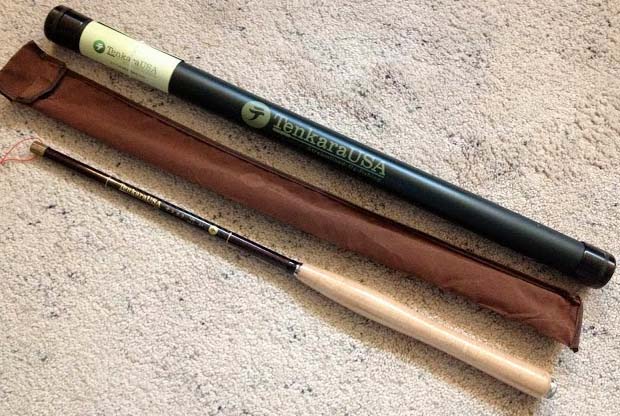A 400 Year Old Japanese Form of Fly Fishing Gains Fans in the U.S.; Thanks to One Person
By James Card / New York Times / Crooked Creek, Arkansas, 2010
[dropcap]M[/dropcap]isako Ishimura waded knee deep into the current, the water temperature perfect for both swimming and soothing relief from the afternoon sun. But Ishimura, 58, had other things in mind as she swept back her rod and flicked the line upstream in a controlled, gentle cast. The soft-hackle fly dropped into the surface film and drifted near a rock undercut.
A shiver vibrated up the line, and Ishimura leaned back with her rod and brought in a scrappy longear sunfish. From a distance it appeared she was fly fishing in the usual style, but the long, supple rod that she cast had no reel, and the line did not run through guides. The line was knotted at the very tip of the rod and formed a direct connection between her and the fish.
That is the minimalist essence of tenkara, a form of traditional Japanese fly fishing that has begun to attract anglers in the United States.
Although the etymology is unclear, the name tenkara is thought to mean “from the sky” or “from heaven,” which may describe the situation from a trout’s point of view: a mayfly gently touches down on a coldwater stream, a free lunch from above. To the angler, the mayfly is an imitation on a hook and an effective and intimate way to connect with the fish.
Tenkara is simply a rod, a line and a hook. The cork-handled rod telescopes down to the size of a lightweight baton for easy transport. Uncapped, it extends to 11 to 13 feet. On the delicate rod tip is a braided nub onto which the leader is tied, usually a rod’s length of furled monofilament and tippet. The fly can be anything the angler wants to use.
American anglers grope for comparisons when sizing up tenkara. Some say it is a modern version of old-fashioned cane pole fishing in which the angler uses a long bamboo rod to plop worms into a honey hole. Others compare it to dapping, a method using an ultralong telescoping rod to dangle and skate a fly across the water’s surface.
It is also much like regular fly fishing, and a tenkara angler can cast tight, aerodynamic loops to deliver a dry fly onto a seam in the current. And it has been compared to Czech nymphing, a form of close-range fly fishing in which the angler keeps a constant tight-line connection to the submerged fly.
All those techniques can be executed with a tenkara rod, but tenkara angling is best appreciated on fast-flowing mountain streams.
Tenkara history can be traced back more than 400 years, when Japanese anglers caught cherry trout with unsplit bamboo rods tipped with horsehair lines tied to simple fly patterns.
Ishimura opened her fly box and held out a traditional tenkara fly. It was a dark-colored, reverse soft-hackle fly, a simple pattern that is easy to tie.
“Tenkara was done by semi-commercial fishermen that sold fish to ryokans, or inns,” Ishimura said. “They didn’t want to spend time making flies and they didn’t want to share their secrets with other anglers. So tenkara flies don’t have names, actually, and if it has a name, it comes from the name of the person who tied it.”
Ishimura, a Japanese citizen with permanent residency in the United States, grew up in Osaka and became obsessed with jazz. The best place in the world to hear it, she was told, was at a club called Bradley’s in New York. She shocked her family by leaving for New York in 1977. While exploring the jazz scene, she met her future husband, Mark Romero, then a sound engineer for jazz musicians. Neither of them fished, and one of their jazz friends hounded them about the joys of fly fishing. In 1989, they fly fished for the first time in the Catskills.
They now travel half the year from their home in Lakeview, Ark., to participate in fly-fishing and fly-tying events across the country. Romero, 60, specializes in tying wild, imaginative flies that push the limits of the art. Ishimura serves as a goodwill ambassador for the International Women Fly Fishers and is captain of Japan’s national fly-fishing team. In 2008, after she became curious about Japanese methods, Ishimura reached out to Dr. Hisao Ishigaki, an authority on tenkara.
Meanwhile, in San Francisco, Daniel Galhardo was researching the history of fly fishing in Japan and learned about tenkara from Web sites. On a trip to Japan in 2008 with his Japanese-American wife, he scouted tackle shops.
Read complete story here . . .
[information]
[/information]
Watch this video and get hooked.
[youtube id=”N40BOFYKR38″ width=”620″ height=”360″]
<







Join the discussion One Comment